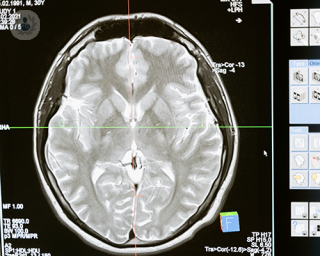Radiosurgery
Miss Anouk Borg - Neurosurgery
Created on: 02-08-2013
Updated on: 08-02-2023
Edited by: Carlota Pano
What is radiosurgery?
Radiosurgery is a form of high-precision radiotherapy in which fine beams of high-dose ionising radiation are used to destroy precisely-selected areas of tissue, rather than removing them with a blade as in traditional surgery.
It uses much higher doses of radiation in the target region, while minimising the dose to surrounding healthy tissue, using a three-dimensional co-ordinate system. This is known as stereotactic radiosurgery. The objective is to administer the appropriate dose that destroys the tumour and achieves maximum localised control.
Radiosurgery is frequently performed with the CyberKnife® and Gamma Knife® machines, although it may also be performed with a linear accelerator or a common radiotherapy machine.

Why is radiosurgery done?
Radiosurgery, like other types of radiotherapy, is primarily used to treat cancer. Due to its accuracy, it is recommended to treat tumours with the following characteristics:
- Hard to access
- Located near vital organs
- Subject to movement within the body
One of its principal uses is in treating smaller brain tumours.
What does radiosurgery consist of?
Before the treatment, the doctor will fit the patient with a frame to hold the head in place, attached to the scalp by four pins or anchors. Previously, the doctor will have anaesthetised the areas where these anchors will go. Alternatively, a thermoplastic mask may be pulled tight over the face and the frame is attached to the mask, which, in turn, attaches to the machine or bed, holding the patient in place.
Once the frame is fixed, scans will be performed, such as CT and/or MRI, which will identify the exact position, size, and shape of the tumour. It is important to note that the treatment does not cause pain to the patient, but rather that the patient lies on the treatment table, which slides inside the radiosurgery machine.
Care after the intervention
Depending on the procedure, the patient may have to stay overnight at the hospital, or may even be able to go home on the same day. Side-effects are not common and should be reported to the doctor immediately.





